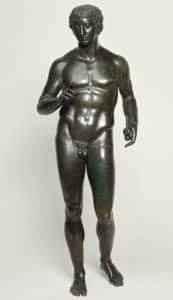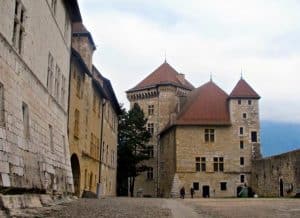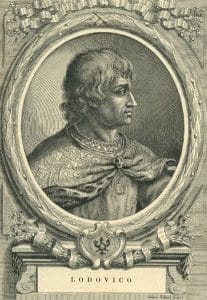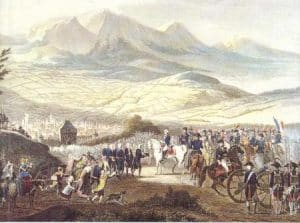The history of Annecy is rich in several important stages such as the Gallo-Roman period, the Middle Ages, the influence of Saint-François-de-Salles, the French revolution, the Sardinian period and the contemporary period with the creation of a new commune.
Annecy, a Roman town
 The shores of Lake Annecy have been occupied since 3100 BC. Annecy was not created until 50 BC and was then called Boutae or Bautas. At that time, Annecy was still only a Roman town and had only 2000 inhabitants, before the fall of the Roman Empire. Discover our file on Annecy in the Gallo-Roman period.
The shores of Lake Annecy have been occupied since 3100 BC. Annecy was not created until 50 BC and was then called Boutae or Bautas. At that time, Annecy was still only a Roman town and had only 2000 inhabitants, before the fall of the Roman Empire. Discover our file on Annecy in the Gallo-Roman period.
The fall of the Roman Empire caused the town to wither following the great barbarian invasions from Gaul, which brought insecurity to the town. These invasions nevertheless heralded the beginning of the feudal era for Annecy.
Annecy in the feudal era
 In 259, the entire town was decimated and the inhabitants massacred following the powerful barbarian invasions. The surviving Annecians were forced to hide in the caves of Mont Veyrier. Once the invasion was over, many of the inhabitants left the town for the surrounding countryside such as Anniciaca (Annecy le vieux). The attacks on Annecy continued until the 6th century. Everything was burnt, looted and destroyed and the last inhabitants decided to leave Boutae.
In 259, the entire town was decimated and the inhabitants massacred following the powerful barbarian invasions. The surviving Annecians were forced to hide in the caves of Mont Veyrier. Once the invasion was over, many of the inhabitants left the town for the surrounding countryside such as Anniciaca (Annecy le vieux). The attacks on Annecy continued until the 6th century. Everything was burnt, looted and destroyed and the last inhabitants decided to leave Boutae.
The town’s activities resumed in the 7th century on the banks of the Thiou; the church of Saint Maurice is the starting point. It was also during this period that Annecy Castle was built. The wars and battles never ceased and opposed the people of Annecy to the bishops of Geneva. The counts of Geneva ended up taking refuge in Annecy in the manor of Novel (plaines des Fins). The town then became the capital of the county.
The last Count of Geneva, by becoming the antipope Clement VII in residence in Avignon, caused the Great Western Schism.
Annecy: a Savoyard town
 Following the death of Clement VII in 1394, the county of Geneva was sold in 1401 to the Count of Savoy Amédée VIII. In 1444, he created an apanage entrusted to a member of his family, ensuring him a great deal of autonomy. This apanage lived on until the 17th century. Janus, son of Louis I of Savoy, made Annecy his official residence while he was Count of Genevois, Baron of Faucigny and Lord of Beaufort-Ugine-Faverges-Gourdans. It was in Annecy that the main organs of the county’s government were established: the county council, the chamber of accounts, the fiscal procurator and the magistrate.
Following the death of Clement VII in 1394, the county of Geneva was sold in 1401 to the Count of Savoy Amédée VIII. In 1444, he created an apanage entrusted to a member of his family, ensuring him a great deal of autonomy. This apanage lived on until the 17th century. Janus, son of Louis I of Savoy, made Annecy his official residence while he was Count of Genevois, Baron of Faucigny and Lord of Beaufort-Ugine-Faverges-Gourdans. It was in Annecy that the main organs of the county’s government were established: the county council, the chamber of accounts, the fiscal procurator and the magistrate.
Janus died in 1491 and Annecy was attached to Savoy from 1491 to 1514, the year in which Charles III bequeathed the Genevois and other regions to his brother Philippe. Annecy is the new centre of an apanage of the Genevois around Ugine.
Annecy: The Rome of the Alps
 Annecy, with its religious influence, had a good dozen convents. Half of the town was owned by different religious orders, which owned churches, convents, workshops, mills, as well as vast lands and forests.
Annecy, with its religious influence, had a good dozen convents. Half of the town was owned by different religious orders, which owned churches, convents, workshops, mills, as well as vast lands and forests.
In the 16th century, when the Calvinist reformation in Geneva prevailed, the Catholics fled to Annecy. It was at this time that a series of beautiful monuments were built (Logis de Nemours, Cathédrale Saint Pierre, Maison Lambert…).
In 1600, Charles Emmanuel I, the Duke of Savoy, and Henri IV, then King of France, came into conflict. The Calvinists took advantage of this to take over regional property. This war ended in the late 1590s and led to the Treaty of Lyon.
In 1602, St François de Sales, the local boy, became bishop of the town. His intelligence and spirituality left a lasting impression on the city and its entire region. Moreover, he inspired a dynamic religious and cultural renewal, the counter-reformation. Annecy thus became the Rome of the Alps.
The French Revolution
 The many Savoyards working in Paris, as well as the writings of Voltaire and Jean-Jacques Rousseau, spread the ideals of the Revolution that was raging in France to the Annecy region. At the end of 1792, the Duchy of Savoy was stormed by the troops of General Moutesquiou-Fezensac, forcing the Savoyard army, civil servants, clergy and the king to take refuge in Piedmont.
The many Savoyards working in Paris, as well as the writings of Voltaire and Jean-Jacques Rousseau, spread the ideals of the Revolution that was raging in France to the Annecy region. At the end of 1792, the Duchy of Savoy was stormed by the troops of General Moutesquiou-Fezensac, forcing the Savoyard army, civil servants, clergy and the king to take refuge in Piedmont.
It was at the end of the same year that the “despotism” was abolished by the assembly of the Allobroges, meeting in the cathedral of Chambéry. No more drudgery and militia. The department of Mont Blanc was born.
The people of Annecy then became French for 23 years. Following the flight of the Duke of Savoy when the French troops arrived, the population had the feeling of being liberated. However, the mass mobilisation of men, the flight of the nobility and clergy, and the anti-religious policies of the revolution eventually forced the inhabitants to rebel.
During this period, the important markets of France were open and many factories were built along the Thiou to benefit from the hydraulic power. In addition, the industrial knowledge of the people of Annecy represented a real potential.
Annecy: a modern city
 In 1866, for the first time in Annecy, the steam train made its appearance which allowed tourism to develop. The town grew slowly during the early 20th century, with new districts such as Les Balmettes, Vovray and La Prairie. Electricity was democratised thanks to the Fier hydraulic power station which has been lighting Annecy since 1906.
In 1866, for the first time in Annecy, the steam train made its appearance which allowed tourism to develop. The town grew slowly during the early 20th century, with new districts such as Les Balmettes, Vovray and La Prairie. Electricity was democratised thanks to the Fier hydraulic power station which has been lighting Annecy since 1906.
The tourist boom in the town was accompanied by an industrial boom with the names of emblematic industries such as: Aussedat, Dunant, Crolard, Léon Laydernier… In 1936, paid holidays enabled the working classes to discover Annecy, the lake and the mountains. The town’s urban development began to decline after the “Trente Glorieuses” in the 1960s and 1970s.
On 1 January 2017, the five inter-municipalities of the Annecy basin merged. Greater Annecy is now made up of 34 communes and nearly 208,000 inhabitants. This grouping brings together several issues such as the improvement of regional development, a reorganisation of transport to promote mobility, as well as economic and tourist development.
It was also on this date that the New Commune of Annecy was created. It brings together the former historic communes ofAnnecy, Annecy-le-Vieux, Seynod, Cran-Gevrier, Meythet and Pringy. The population of Annecy thus exceeds 120,000 inhabitants. In 2020, the municipal elections elected a mayor with a green bias after more than 60 years of centre-right mayors.
The city of Annecy is particularly attractive both in terms of leisure and economic activities. Most mountain and water sports are practiced. On a cultural level, many events are organised throughout the year. Traditions are also honoured with the Fête du Lac in August and the Descente des Alpagesin October. The economic dynamism is linked to the industrial fabric, the moving image and mechatronics. The tourist activity also generates a significant employment offer. Tourism outside the summer and winter seasons allows people to discover the Annecy region outside of the main tourist periods. In 2020 and 2021, Annecy was ranked first in France’s cities where it is good to live.
















